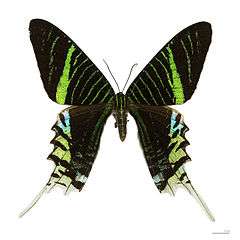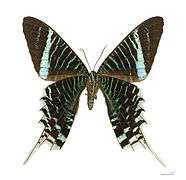Urania leilus
Urania leilus, the green-banded urania, is a day-flying moth of the family Uraniidae. The species was first described by Carl Linnaeus in his 1758 10th edition of Systema Naturae. It is found in tropical South America east of the Andes, including Suriname, French Guiana, eastern Colombia, Venezuela, eastern Ecuador, Brazil, northern Bolivia, eastern Peru, and Trinidad. It has been recorded as a vagrant to the central and northern Lesser Antilles such as St. Kitts, Barbados and Dominica.[1][2] The habitat consists of riverbanks in primary and secondary rainforest at elevations between sea level and about 800 m (2,600 ft).
 Dorsal side
Dorsal side Ventral side
Ventral side
| Green-banded urania | |
|---|---|
.jpg) | |
| Tambopata National Reserve, Peru | |
| Scientific classification | |
| Kingdom: | |
| Phylum: | |
| Class: | |
| Order: | |
| Family: | |
| Genus: | |
| Species: | U. leilus |
| Binomial name | |
| Urania leilus | |
| Synonyms | |
| |
It is sometimes confused with the similar U. fulgens, but that species is found west of the Andes in South America, Central America and Mexico, is slightly smaller and has less white to the "tail".[2] The two have been treated as conspecific.[2]
The wingspan of U. leilus is about 70 mm (2.8 in).
As appears to be the case for all Urania, the larvae of U. leilus feed exclusively on species of the toxic spurge Omphalea.[3]
References
- Barnes, M.J.C. (2002). "Urania leilus". Moths of the Grenadines. Retrieved 12 October 2011.
- Smith, N.G. (1972). "Migrations of the day-flying moth Urania in Central and South America". Caribbean Journal of Science. 12: 45-58
- Lees, D.C. & Smith, N.G. (1991). "Foodplant Associations of the Uraniinae (Uraniidae) and their Systematic, Evolutionary, and Ecological Significance". Journal of the Lepidopterists' Society. 45(4): 296-347.Archived 2012-08-02 at the Wayback Machine
| Wikimedia Commons has media related to Urania leilus. |